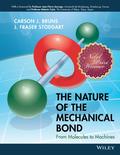The Nature of the Mechanical Bond
From Molecules to Machines

1. Edition December 2016
784 Pages, Hardcover
Wiley & Sons Ltd
"The story is told by THE inventor-pioneer-master in the field and is accompanied by amazing illustrations... [it] will become an absolute reference and a best seller in chemistry!"
--Alberto Credi
"... the great opus on the mechanical bond. A most impressive undertaking!"
-- Jean-Marie Lehn
Congratulations to co-author J. Fraser Stoddart, a 2016 Nobel Laureate in Chemistry.
In molecules, the mechanical bond is not shared between atoms--it is a bond that arises when molecular entities become entangled in space. Just as supermolecules are held together by supramolecular interactions, mechanomolecules, such as catenanes and rotaxanes, are maintained by mechanical bonds. This emergent bond endows mechanomolecules with a whole suite of novel properties relating to both form and function. They hold unlimited promise for countless applications, ranging from their presence in molecular devices and electronics to their involvement in remarkably advanced functional materials. The Nature of the Mechanical Bond is a comprehensive review of much of the contemporary literature on the mechanical bond, accessible to newcomers and veterans alike. Topics covered include:
* Supramolecular, covalent, and statistical approaches to the formation of entanglements that underpin mechanical bonds in molecules and macromolecules
* Kinetically and thermodynamically controlled strategies for synthesizing mechanomolecules
* Chemical topology, molecular architectures, polymers, crystals, and materials with mechanical bonds
* The stereochemistry of the mechanical bond (mechanostereochemistry), including the novel types of dynamic and static isomerism and chirality that emerge in mechanomolecules
* Artificial molecular switches and machines based on the large-amplitude translational and rotational motions expressed by suitably designed catenanes and rotaxanes.
This contemporary and highly interdisciplinary field is summarized in a visually appealing, image-driven format, with more than 800 illustrations covering both fundamental and applied research. The Nature of the Mechanical Bond is a must-read for everyone, from students to experienced researchers, with an interest in chemistry's latest and most non-canonical bond.
Preface
Acknowledgments
About the Authors
Abbreviations, Acronyms, and Symbols
Part 1 Introducing Mechanical Bonds
1 An Introduction to the Mechanical Bond
Conspectus
Introduction
1.1 The Ubiquity of the Mechanical Bond
1.2 Representing Molecular Mechanical Bonds
1.3 Aesthetics of Mechanical Bonds
1.4 Evolution of Mechanostereochemistry
References
Part 2 Making Mechanical Bonds
2 The Fundamentals of Making Mechanical Bonds
Conspectus
Introduction
2.1 Statistical Synthesis
2.2 Directed Synthesis
2.3 Template-Directed Synthesis
2.4 Active Template Synthesis
Conclusions and Outlook
References
3 Making Mechanical Bonds Under Thermodynamic Control
Conspectus
Introduction
3.1 Slippage
3.2 Self-Assembling Metallo-Organic MIMs
3.3 Mechanical Bond Formation by Condensation
3.4 Mechanical Bond Formation by Olefin Metathesis
3.5 Mechanical Bond Formation by Reversible Nucleophilic Reactions
3.6 Surface-Mounted MIMs
Conclusions and Outlook
References
Part 3 Cultivating Mechanical Bonds
4 Molecular Topologies and Architectures with Mechanical Bonds
Conspectus
Introduction
4.1 Catenane Topologies
4.2 Rotaxane Architectures
4.3 Other Architectures with Mechanical Bonds
Conclusions and Outlook
References
5 The Stereochemistry of the Mechanical Bond
Conspectus
Introduction
5.1 Dynamic Mechanostereoisomerism
5.2 Static Mechanostereoisomerism
Concluding Remarks
References
6 Molecular Switches and Machines with Mechanical Bonds
Conspectus
Introduction
6.1 Redox-Driven Switches
6.2 Photo-Driven Switches
6.3 Acid/Base-Driven Switches
6.4 Cation-Triggered Switches
6.5 Anion-Triggered Switches
6.6 Switches Driven by Molecular Recognition
6.7 Switches Driven by Covalent Reactions
6.8 Solvent-Driven Switches
6.9 Thermally Driven Switches
6.10 Pressure-Driven Switches
6.11 Switches Driven by Electric Fields
6.12 Switches Driven by Mechanical Force
6.13 Beyond Translation and Circumrotation
6.14 Condensed-Phase Switching
6.15 Mechanomolecular Motors and Machines
Conclusions and Outlook
References
Appendix A: Glossary of Terminology
Appendix B: Cover Art Gallery
Index
Angewandte Chemie International Edition, 8th December 2016
"The book contains numerous schemes and illustrations of high quality. These facilitate the visualization of the molecular structures and of the chemical and dynamical processes. Each chapter contains approximately 500 to 1500 references and the book presents a total of 3400 unique references which corresponds to the main publications in this research domain. Undoubtedly, the book will be a most useful tool for all researchers interested in mechanically interlocked molecules ... One can anticipate, I believe, that The Nature of the Mechanical Bond will open new horizons for generations of readers and will stimulate the creativity of many architects of matter who wish to design more and more fascinating molecular systems."
Acta Cryst, November 2017
"... a spectacular book! Many chemists will want to have it on their desks and regard it as the holy writ."
--Josef Michl
"The story is told by THE inventor-pioneer-master in the field and is accompanied by amazing illustrations... [it] will become an absolute reference and a best seller in chemistry!"
--Alberto Credi
"... the great opus on the mechanical bond. A most impressive undertaking!"
--Jean-Marie Lehn
"I love the first chapter, and its romp through the mechanical bond."
--Roald Hoffman
"... what a wonderful read.... I thoroughly enjoyed the scientifically atypical perspective. A real pleasure."
--Bruce Gibb
"... comprehensive coverage [and] exceptional top-quality graphics... this [is a] definitive book."
--Paul Beer
J. Fraser Stoddart is a Board of Trustees Professor of Chemistry at Northwestern University. By playing a major role in introducing the mechanical bond into molecules, he is one of the few contemporary chemists to have contributed to the opening up of an entirely new field of chemistry. He has pioneered the development of bistable mechanically interlocked molecules (MIMs) for use in molecular electronic devices and drug delivery vehicles. In 2016 he shared the Nobel Prize in Chemistry with Jean-Pierre Sauvage and Ben Feringa for the design and synthesis of molecular machines.


